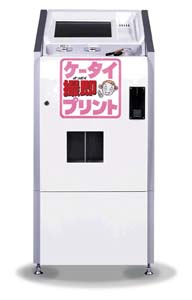All Aboard! Next Stop: Digital Print Station
Back to Contents of Issue: April 2003
|
|
|
|
by Gail Nakada |
|
 NEXT-GENERATION DIGITAL PHOTO vending machines, or "print stations," from Omron, NEC and Fuji Film all premiered in the Japanese market in late fall 2002, and they've been proliferating ever since. These machines juggle memory sticks, compact flash memory cards, PC cards, MO disks, CD ROMs and floppy disks. They are fast, fun and easy to operate. Users attach media through one of several portals or plugs, tap the touch screen to select size, style (sticker prints, standard print, frames, graffiti scribbles) and quantity, then feed in some coins. Around 20 seconds later, out pops a professional-quality print. A one-month test of Omron's Sasoku Print unit in May 2002 at the Tokyu Store in busy Hiyoshi station turned out over 10,000 prints. Encouraging? Yes. But corporate heads hardly needed additional research to tell them that digital cameras are what the public wants. Data from Japan's Camera & Imaging Products Association shows Japanese snapped up 6.55 million digital cameras in 2002 -- an increase of 36 percent over the previous year. Meanwhile, analog camera sales fell 26 percent to around 2.24 million. This year, analysts are predicting sales of digital units to reach a robust 7.7 million. Of course, there are a lot more players on the Japanese photographic field than Canon, Kodak, Minolta, et al. A camera in Japan is increasingly likely to flash an i-mode or J-Phone logo; sales of camera- equipped cellphones by January 2003 surpassed 15 million (NTT DoCoMo sold 5 million; J-Phone, 7.91 million; KDDI, over 2.47 million). Photo phones are the No. 1 trend for the mobile market and a huge digital-photo opportunity -- but getting those pictures out of the phone and into the real world is a major challenge for the average user. The most popular options thus far have been: download photos via a phone/PC connection through online developers, who then mail prints one to several days later; or visit one of several convenience store chains/photo shops with units equipped (sort of) to handle mobile phone photos. But getting prints developed through either of these methods is not fast, not fun and not something you can do on the spot with friends during a day (or night) of good times. The spontaneity these keitai cameras encourage and the desire to share prints cry out for a more impulse-friendly method. So, while photo vending machine makers were scrambling to secure prime locations and contracts in October, Omron and NEC were putting the finishing touches on print stations to tempt camera keitai owners.
Photo phones are the No. 1 trend -- The newest version of Omron's Sasoku Print, released in January and rolling out nationwide this April, can handle phones from any provider. Creating prints directly from phone to machine means no transmission fees, plus print quality is not affected by the image data compression of transmitted mail. Best of all, there's virtually no waiting. Omron expects camera keitai sales to grow to 21 million within the current business year, and the company is giving keitai photo stations a lot of attention.
Print station ubiquity NEC is betting on its keitai-enabled print station Primode to grab a share of the mobile photo demographic. At press time, NEC was in the process of setting up Primode print stations in 100 NTT DoCoMo shops, with further distribution planned for fast-food outlets (which the company charmingly calls "hamburger shops") and convenience stores. In all, the company says it hopes to have Primode in 10,000 locations by the middle of the current year. Print costs are pegged at JPY50 per sheet. More units from different manufacturers are undoubtedly popping up now, as film-related companies look to sail new digital revenue streams. The rollout of this consumer service flows easily into manufacturers' pre-existing relationships with vendors and joint ventures. Omron, for example, makes many of those ubiquitous "print club" machines at game centers and superstores, and it provides content for mobile communications. Fuji Film, which controls 70 percent of the domestic film market, and NEC can deploy units through their network of electronic retailers, film and camera-store outlets. Since they are precision machinery makers themselves, print station manufacturers are able to keep production almost entirely under their corporate umbrella, right down to the roller paper. Impulse shopping move over -- welcome to the era of impulse digital-developing. Smile! @ |
|
Note: The function "email this page" is currently not supported for this page.






